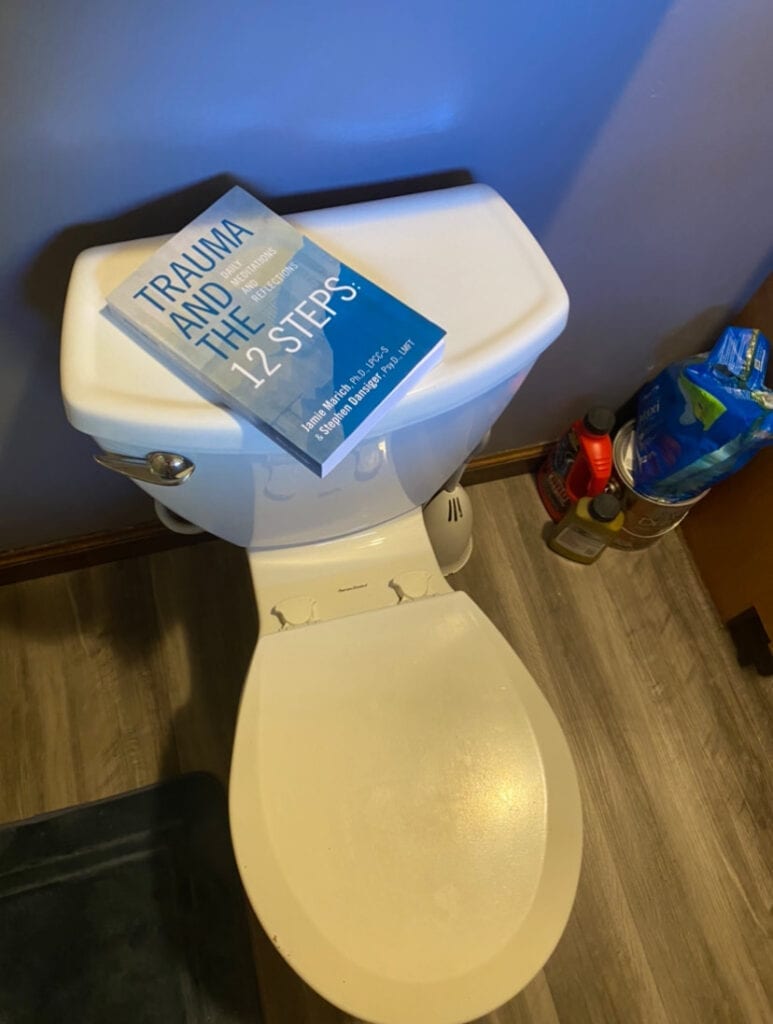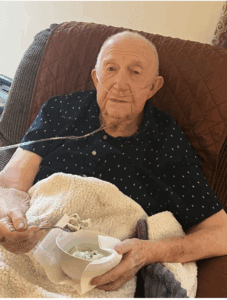There is a highly lauded book in both the yoga and recovery communities called Meditations from the Mat (Rolf Gates, 2002). My experience was slightly less elegant yet just as impactful. Before ever making my way on to a yoga mat, I learned about the power of prayer and meditation on my toilet seat.
I found a program of recovery when I worked in post-war Bosnia-Hercegovina from 2000-2003. Serving in various humanitarian aid roles, I met Janet Leff, my first recovery sponsor. The story of our connection is celebrated in many of my books since her willingness to work her own recovery program created that attraction rather than promotion that inspired me to try on recovery for myself. After finding a validating presence with her and beginning to attend some 12-step meetings, Janet suggested, in our daily check-ins, that I start my morning with prayer. Although spiritual abuse is a big part of my story, I never lost faith in a God of my understanding, so it wasn’t the prayer part that bothered me. Rather, praying first thing in the morning made me wince.
“Janet,” I protested, “I’m not a morning person. I’m lucky if I roll out of bed, use the toilet, maybe take a shower, and then get to work.”
“Oh, you use the toilet,” she observed.
“Why don’t you place the meditation reader I gave you (Twenty-Four Hours A Day) on your toilet seat?,” she continued, “That way when you do your morning business, you’ll have to pick up the book, and while you’re sitting there doing your thing, give the page for the day a read.”
I was willing to give it a try.
I still have an image on the horrible pink toilet seat in the apartment I rented at the time, and that small little book sitting there. Every morning I picked it up and read the short page for the day. Some resonated with me, others did not. Yet completing the reading was the most solid reminder I had to connect with the God of my understanding and ask that Higher Power to keep me sober for the day. All while I peed.
While I don’t recall the exact science, I remember hearing in my early studies that if you can do something every day for 21-30 days, it becomes a habit. Do it for 45-60 days, and it becomes part of your lifestyle. Over eighteen years later, I still read a page from a meditation or some type of spiritual book every morning as part of my routine. Although I’ve not needed to keep the book on the toilet for many years, I generally turn to my nightstand to grab the book I’m working on first thing in the morning after saying my prayers. And I’ve become enough of a morning person to actually have some semblance of a daily routine that includes physical yoga practice. This morning practice is my life line, especially on days when I really have to be on for my work.
And most importantly, I am still sober.
After eighteen years, two marriages, severe losses, scores of changes in the political and social climate, a pandemic, building a business, and writing many books…I am still sober.
While I credit the seeds of my recovery being planted by Janet, I specifically highlight this daily practice of reading my meditation book on the toilet as being the game changer. Her suggestion taught me how to set a reminder in my path, and I, for one, needed that extra assistance to get the proverbial ball of my recovery rolling. Small changes like these are the building blocks of life style change that are vital for recovery, regardless of the program you practice or approach to recovery you embrace.
I often hear clients say, “Yeah, I know you show me all of these things, and I forget to do them.”
Inspired by Janet’s example, I meet that challenge with the question, “What reminder can we help to set in your path.”
I will share my meditations from the toilet seat story, and offer other suggestions as well—placing a post-it note on the bathroom mirror or in other strategic places and using the notes feature (with an alarm) or even setting the lock screen on your smartphone to easily see your reminders. If you wear eyeglasses, some folks will put their glasses in a strategic place that issues the reminder to pray, meditate, or engage in some kind of other healthy activity. For people who pray on their knees, it can be a common practice to put one’s glasses under the bed so that you are required to get down on your knees first thing in the morning. While this strategy may not be for everyone, the spirit of the suggestion hopefully resonates with you.
Lately I’ve been feeling the call to go back to some of these basics of my recovery program, especially with the world being in such upheaval and with me continuing to heal from a traumatic death of a friend at the end of last year. So I decided to place the recovery reader that I’ve been writing and compiling over the last few years (along with my professional partner Dr. Stephen Dansiger on my toilet seat). When I held Trauma and the 12 Steps: Daily Meditations and Reflections in my hand for the first time in early October, chills moved through my body as I marveled at what it means to come full circle. From using a meditation reader to get started with recovery to being able to write one based on my work, I am awestruck by what recovery gave me and continues to give me.
The cool thing about circles is that there is never a defined beginning or a defined ending—when we complete one rotation of the circle, we can always begin again. This idea captures the spirit of mindfulness practice and the rule of St. Benedict, and I’ve long viewed it as a primary principle of recovery. So my copy of Trauma and the 12 Steps: Daily Meditations and Reflections now sits on the top of my toilet in my Northeast Ohio home. Every morning I’ve picked it up to read it, I offer gratitude for that dingy toilet in the rented space, for the pilgrimage abroad that led me home to myself, and for the life and example of Janet Leff.

Stilettos and Self-Disclosure: When Teaching Becomes Embodied Expression
When I was in sixth grade, my cousin and I went to a Lady Gaga concert in Detroit. It was, in many ways, a queer













